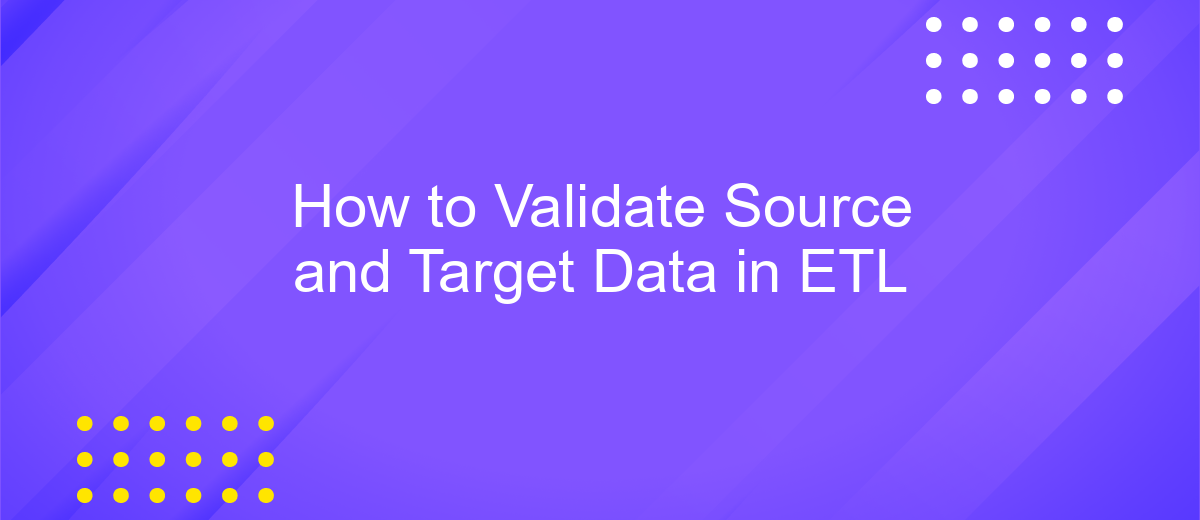How to Validate Source and Target Data in ETL
In the realm of data integration, ensuring the accuracy and consistency of data is paramount. This article delves into the essential steps for validating source and target data in ETL (Extract, Transform, Load) processes. By implementing robust validation techniques, you can safeguard data integrity, minimize errors, and enhance the reliability of your data-driven decisions.
Introduction
In the realm of Extract, Transform, Load (ETL) processes, ensuring the accuracy and consistency of data between source and target systems is paramount. Data validation is a critical step that helps identify discrepancies and maintain data integrity throughout the ETL pipeline. By implementing robust validation techniques, organizations can ensure that their data remains reliable and actionable.
- Check for data completeness and accuracy
- Verify data transformation rules
- Ensure data consistency across systems
- Automate validation processes for efficiency
Leveraging tools like ApiX-Drive can simplify the setup of integrations and facilitate seamless data validation between disparate systems. ApiX-Drive offers a user-friendly interface and powerful features that streamline the configuration of data workflows, ensuring that both source and target data are aligned accurately. By incorporating such tools, organizations can enhance their ETL processes, reduce manual effort, and achieve higher data quality standards.
Data Sources

Data sources play a crucial role in the ETL (Extract, Transform, Load) process, as they provide the raw data that needs to be transformed and loaded into the target system. These sources can range from traditional databases and flat files to more complex structures like APIs and cloud-based data warehouses. Ensuring the reliability and accuracy of these data sources is fundamental to maintaining the integrity of the ETL process. Each data source may require different methods of extraction, depending on its nature and the type of data it holds.
Integrating multiple data sources can be challenging, especially when dealing with diverse formats and systems. Tools like ApiX-Drive simplify this process by providing a platform for seamless integration. ApiX-Drive supports various data sources and offers automated workflows to ensure data is consistently and accurately extracted. By using such services, organizations can streamline their ETL processes, reduce the risk of errors, and ensure that the data being transferred is validated and reliable. This ultimately leads to more accurate and trustworthy insights derived from the ETL process.
Data Profiling

Data profiling is a crucial step in the ETL process that involves analyzing the source data to understand its structure, content, and quality before it is transformed and loaded into the target system. This helps in identifying any inconsistencies, missing values, or anomalies that need to be addressed to ensure data integrity.
- Examine data types and formats to ensure consistency.
- Identify and handle missing or null values.
- Detect and correct data anomalies and outliers.
- Assess data distribution and relationships between different data sets.
- Generate summary statistics to gain insights into the data.
Effective data profiling can be facilitated by using integration tools like ApiX-Drive, which help in automating the data extraction and profiling process. By leveraging such tools, organizations can streamline their ETL workflows, reduce manual effort, and improve the accuracy of their data validation processes, ultimately leading to higher data quality and reliability.
Data Cleansing

Data cleansing is a crucial step in the ETL process to ensure the integrity and quality of the data. It involves identifying and rectifying errors, inconsistencies, and inaccuracies in the source data before it is loaded into the target system. This step is essential for maintaining the reliability of the data and ensuring that subsequent analyses are accurate and meaningful.
Effective data cleansing can be achieved through a combination of automated tools and manual processes. Automated tools can quickly identify and correct common issues such as duplicate records, missing values, and formatting errors. Manual processes, on the other hand, are necessary for more complex issues that require human judgment and expertise.
- Identify and remove duplicate records.
- Fill in or correct missing values.
- Standardize data formats.
- Validate data against predefined rules and criteria.
- Eliminate inconsistencies and inaccuracies.
Utilizing integration services like ApiX-Drive can streamline the data cleansing process by automating the detection and correction of common data issues. ApiX-Drive offers robust tools for data validation and transformation, ensuring that your data is clean and ready for analysis. By leveraging such services, organizations can save time and resources while maintaining high data quality standards.


Data Transformation and Validation
Data transformation is a crucial step in the ETL process, where raw data from the source is converted into a format suitable for analysis or reporting. This involves cleaning, filtering, aggregating, and enriching the data to ensure consistency and accuracy. During this phase, various rules and business logic are applied to align the data with the target schema. Tools like ApiX-Drive can facilitate this process by automating data transformations and ensuring seamless integration between disparate systems.
Validation is equally important to ensure data integrity and quality. This step involves checking the transformed data against predefined rules and constraints to identify any discrepancies or errors. Validation can include range checks, format checks, and consistency checks to ensure the data meets the required standards. Automated validation tools and scripts can be employed to streamline this process, reducing the risk of human error and ensuring that only accurate and reliable data is loaded into the target system.
FAQ
How do I ensure data consistency between source and target systems in ETL?
What are some common methods for validating data during the ETL process?
How can I automate data validation in ETL processes?
What should I do if discrepancies are found during data validation?
How often should I validate data in an ETL process?
Routine tasks take a lot of time from employees? Do they burn out, do not have enough working day for the main duties and important things? Do you understand that the only way out of this situation in modern realities is automation? Try Apix-Drive for free and make sure that the online connector in 5 minutes of setting up integration will remove a significant part of the routine from your life and free up time for you and your employees.

